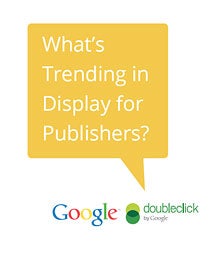 Today, on the Doubleclick Publisher blog, Google released a new report showing a range of display ad trends for publishers using its DoubleClick for Publishers (DFP) ad server, the DoubleClick Ad Exchange, and Google AdSense network.
Today, on the Doubleclick Publisher blog, Google released a new report showing a range of display ad trends for publishers using its DoubleClick for Publishers (DFP) ad server, the DoubleClick Ad Exchange, and Google AdSense network.
For example, not unexpectedly, Google’s Jonathan Bellack, Director of Product Management, Display Advertising, states, “Sell-through rates (the percentage of reserved ad inventory sold by the publisher’s sales team) vary according to the time of year, with higher sell-through rates trending towards the end of the year.” End of year holidays help drive plenty of purchase intent. And although “big ads” (my words) are on the rise, “nearly 80% of all impressions are the ad unit ‘three musketeers’: the medium rectangle, leaderboard, and skyscraper still comprise the vast majority of ads served.” En garde! And, read more. And, download the report (PDF).
AdExchanger spoke to Bellack about the results.
AdExchanger: I’m curious about “brand‑friendly premium units” you mention. What qualifies as a brand‑friendly premium unit for Google?
JB: We are referring to all the newer, more engaging or larger formats that are out there. The OPA has some. The IAB has Rising Stars. We are seeing growth in those new units -the YouTube masthead on its home page, that’s another example.
What do you see happening down the road with these premium units?
In general, you’re seeing a trend towards larger units. The 468×60 is shrinking. You also have the narrower skyscraper – the 120×600 – which is very small and shrinking. The units that have larger growth tend to be the bigger ones. And the rise in mobile formats is spectacular when you look at sizes like the 320×50. On an absolute percentage basis, it’s still small, but it’s got the highest growth rate by far of anything we’re tracking here.
How is data helping with these growth rates? Can you speak to that at all in terms of driving better performance and data-driven advertising?
In some ways it’s a matter of different kinds of purposes. When you’re talking about size, you’re talking about the user’s experience and engagement with the ad and that’s what’s driving a lot of these larger sizes. It’s brand impact -it’s engagement with rich content within the ad. Data, then, would be more of an enabler of trying to get that experience in front of the right people. For example, we’ve done some interesting pilots with optimizing to engagement so that you show an ad for a film to people that are more likely to be interested in watching a movie trailer. That kind of thing can have enormous impact.
You’ve offered some data on geographic trends. But, looking even more more broadly – so North America, Latin America, Europe, Asia, overall – do you see any one of these regions moving more quickly than others?
In emerging markets, as countries advance, they’re also becoming more connected. And as a country’s economy grows it starts to be more able to support an advertising business of a large, and even accelerating, size. That’s one of the most interesting parts of my job – talking about the publishers in many different countries. They may start off using AdSense. Then they start working with local networks. Next, they’re ready to start putting together a sales team. And finally they’re saying, “Hey, I need an ad server to put this together…”
If you think of years ago, the Internet was an English medium because it was mostly based in the US and the rest of the world is playing around with it.” Obviously now the Internet is truly global. The same holds true for Internet advertising.
You show 11 percent of impressions overall coming from China. Is that a significant growth from what you’ve seen previously?
We don’t have anything to share right now about the growth rate in China. But, I will say we have a significant software development nexus for some of our publisher ad products in Shanghai. It’s been an area we’ve been expanding aggressively, because we’ve got a great team there.
Finally, in terms of Ad Exchange versus AdSense, what can you say about the difference in inventory being made available through both of those right now by publishers? Is there a difference?
If you think about it conceptually, basically you have two types of buyers. You’ve got buyers that are buying through AdWords. Then you have buyers that are buying through the Ad Exchange, either through a UI or increasingly through RTB and programmatic buying. If you think of sellers you have publishers that have a primary relationship with AdSense, especially a lot of the lower torso and tail publishers. And they’re able to make their inventory available to [Ad Exchange] buyers through a feature of AdSense called Google Certified Ad Networks.
A lot of publishers leave that on by default, but publishers can block individual networks or decide they don’t want to work with it at all. Then you have publishers who have a primary relationship with the Ad Exchange and to them the world looks like there are a bunch of [Ad Exchange] buyers, one of which is all of that aggregated AdWords advertisers.
By John Ebbert











